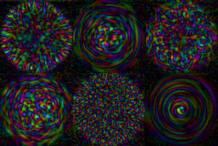Jun 21 2021
A group of physicists, headed by Dr. David Phillips from the University of Exeter, have introduced a new method to regulate light that has been scattered by passage via a single hair-thin strand of optical fiber.
 Shown are six patterns depicting how light that has passed through an optical fiber is scrambled. The brightness is proportional to the intensity of the light fields, and the color is proportional to the optical phase of the light fields. Image Credit: University of Exeter.
Shown are six patterns depicting how light that has passed through an optical fiber is scrambled. The brightness is proportional to the intensity of the light fields, and the color is proportional to the optical phase of the light fields. Image Credit: University of Exeter.
Such ultra-thin fibers offer immense potential for advanced medical endoscopes, allowing high-resolution imaging deep within the body at the tip of a needle.
Traditional endoscopes measure millimeters wide and have only a limited resolution, so they cannot be used for examining individual cells. On the other hand, single optical fibers are roughly 10 times narrower and can allow relatively higher-resolution imaging — sufficient to analyze the traits of individual cells directly within the living tissue. Generally, cells can be viewed as soon as they are taken outside the body and positioned under a microscope.
The catch is that you cannot look directly through optical fibers because they scatter the light that is passed through them. This issue can be resolved by initially calibrating an optical fiber to figure out how it blurs images, and subsequently using this calibration data as a key to decode the images obtained from the scrambled light.
Earlier in 2021, Dr. Phillips’ team developed a method to quantify this key very quickly, in association with scientists from Boston University in the United States and the Liebniz Institute of Photonic Technologies in Germany.
The quantified key is very delicate and can easily alter if the fiber is twisted or bent, thus making it extremely difficult to deploy this technology in real clinical settings. To address this issue, the Exeter-based researchers have now devised a new method to monitor how this image unscrambling key alters while the fiber is being used.
This offers a new way to sustain high-resolution imaging even as a solo fiber-based micro-endoscope bends. The team achieved this by borrowing an idea most often used in astronomy to see through atmospheric turbulence, and leveraging it to look through optical fibers.
This technique depends on a “guide-star” — which, in this example, is a compact, brightly fluorescing particle located on the fiber’s end. The light obtained from the guide-star deciphers how the key alters when the fiber flexes, thus preventing disruption of the imaging process.
This is a major advancement in the development of flexible ultra-thin endoscopes. These imaging devices could be utilized to direct biopsy needles to the right site and help detect diseased cells inside the body.
We hope that our work brings the visualisation of sub-cellular processes deep inside the body a step closer to reality – and helps to translate this technology from the lab to the clinic.
Dr David Phillips, Associate Professor in Physics and Astronomy Department, University of Exeter
The new study was performed in association with scientists from the Liebniz Institute of Photonic Technologies in Germany, and the Brno Institute of Scientific Instruments in the Czech Republic. The research was made possible with financial support from the Royal Academy of Engineering and the Royal Society in the United Kingdom, the European Research Council, and the Chinese Scholarship Council.
Journal Reference:
Li, S., et al. (2021) Memory effect assisted imaging through multimode optical fibers. Nature Communications. doi.org/10.1038/s41467-021-23729-1.